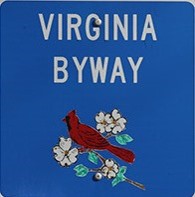 Let’s take a break from DEI; the shortcomings of UVa, W&M and the rest of higher education; and all the other issues that get us riled up.
Let’s take a break from DEI; the shortcomings of UVa, W&M and the rest of higher education; and all the other issues that get us riled up.
Virginia is an interesting state to travel and see.
I have always liked to travel the back roads. It is slower than the interstates and the primary highways, but these byways can be so much more interesting.
I don’t know if this is true of other states, but throughout the countryside of Virginia there are a lot of official markers showing place names, but seemingly there is nothing there. Sometimes the markers appear on the state highway map distributed by the Virginia Department of Transportation; sometimes, not. These “named places” are not random and, if one is willing to dig a little, there is often a story behind them. They were used to designate distinct places in rural Virginia that nearby residents could use as a reference point and sometimes as a place to gather. The reference point could be a building, intersection, store, etc. Eventually, the names were used to denote the surrounding community and often are in use today.
About two weeks ago, as I was rambling around western Goochland County and Fluvanna County between Rt. 250 and the James River, I came across several of these “named places.” Here is one sign by the side of the road. There were a couple of houses around, but they did not seem associated with the sign. This one does not appear on the map.
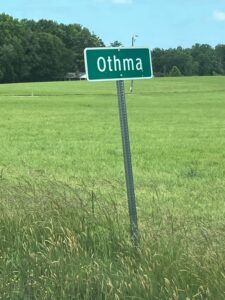
Apparently, this was the site of a two-room school by that name in Goochland in the early 20th century.
Here is another one that does not appear on the map. It was in the yard of what looked to be an older house that had been renovated.

Sources I consulted did not provide a source of the name, but if one Googles “Enon, Va. Goochland County.” Zillow will show you several houses and plots of land for sale in the Enon community.
This one does show up on the map. There is an intersection and a couple of houses. I have never seen one constructed like this. Apparently, someone wanted to be sure that travelers realized that “Fife” was comprised of the area in both directions.
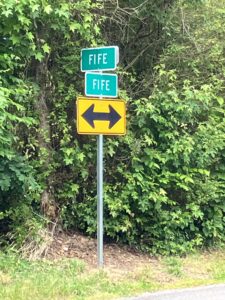
The community of Fife is still viable. There is a Fife Volunteer Fire and Rescue Company. Near this intersection stands the one surviving “Rosenwald” school built in Goochland County in the early 1900’s for Black students. (A foundation established by Julius Rosenwald, a wealthy Chicago businessman, was instrumental in establishing these schools all over the South.) The building looks much like it did when it was being used as a school and today is a museum operated by Goochland County.
The section of Rt. 6 along the James River from western Goochland through Fluvanna and into Albemarle County has several places of interest. Our Bacon’s Rebellion colleague, James Wyatt Whitehead, has often referred to Fork Union Military Academy. That private school is located on this route at, of course, Fork Union. The buildings are impressive:
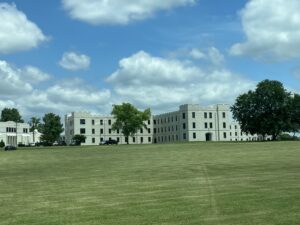
There definitely is little around here to distract the cadets from their studies.
The state highway map shows “Dixie” just before one gets to Fork Union. I somehow missed that sign. I will look for it when I am back in that area.
Traveling west, before one gets to Fork Union, there is Columbia. Here, Rt. 6 is close to the river and the railroad. Looming over the road is a high cliff and at road level is exposed granite that is about 450 million years old. The sides of the highway in this area are littered with dilapidated and crumbling buildings. This building constitutes the only business here:
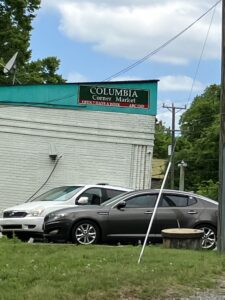
However, Fluvanna County informs the traveler that Columbia did have a notable past:
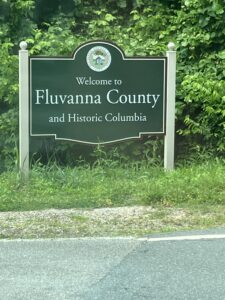
Columbia is situated at the confluence of the James and Rivanna Rivers. It was strategically important in the Commonwealth’s colonial times, first as a trading post on the western frontier and then as the location of the state’s chief arsenal during the Revolutionary War.
After the war, Columbia, chartered as a town in 1788, prospered as a shipping point on the James River for the tobacco trade and as an important terminal for the canals linking Richmond with Lynchburg and Charlottesville.
The opening of gold mines in Fluvanna County in the mid-1800’s brought more people to Columbia. At one time, the town had seven taverns, a sure sign of prosperity. There were also four churches, a bank, and profitable milling and ferry businesses. There is a legend that the town came within a few votes of being designated the capital of the state.
After the Civil War, the railroad brought tons of freight and hundreds of passengers through the town each year, enabling the town to prosper, even during the Depression. By the mid-1950’s, however, passenger and mail trains were no longer stopping in Columbia and freight trains slowly disappeared over the next decade.
What was key to Columbia’s early prosperity — the James River — also led to its downfall. Most of the town’s businesses and manufacturing facilities lay along River Road (Rt. 6) in the flat plain between the river and the steep granite cliff, the outcropping of which is visible along the side of the highway. The churches and many of the residences are higher up on the hill. Floods caused by Hurricane Camille (1969) and Hurricane Agnes (1972) pretty much destroyed the commercial part of the town and the town’s tax base. What survived those floods was finished off a few years later by Hurricane Juan (1985).
Like residents in other small declining towns, the people of Columbia did not give up easily. In 1990, they put the town up for sale. Actually, it was one absentee landlord who owned many of the buildings and lots in Columbia through inheritance, along with other property owners, who decided to market the town as a package deal. The asking price was $2 million. The hope was that the town would get designated as a National Historic District and a developer would build something along the lines of Williamsburg. Or, that some developers would want to get in on the ground floor as Richmond continued to expand westward. There were no takers.
In 2003, there was another spark of hope. The town, by then down to 50 residents, secured a federal $718,000 grant to begin rebuilding with the aim of becoming a historical tourist magnet for central Virginia. The money was used primarily to repair the town’s water distribution system, which tended to freeze in the winter, and to repair homes belonging to low- and middle-income residents.
Needless to say, that hope died, too. By 2015, the town budget was $4,000. There were 34 residents eligible to vote. In that year 19 of them voted in a referendum on whether to abolish the town and become an unincorporated part of Fluvanna County. The question passed on a vote of 18-1. The 2016 General Assembly obligingly enacted legislation revoking the town’s charter.
As you travel Virginia’s backroads, which I encourage you to do, remember that there are stories behind those place name markers you see along those roads.
Sources for history of Columbia:
https://www.ourmidland.com/news/article/Virginia-River-Town-Seeks-New-Life-7085098.php


